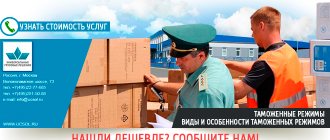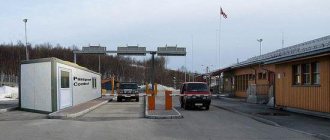Customs law. Crib
3. Customs territory and customs border
All customs operations are carried out within the customs territory of the Russian Federation. It is the scope of the norms of customs law and the implementation of the tasks of the customs policy of the Russian Federation. In accordance with clause 1 of. 2 of the Labor Code of the Russian Federation, the territory of the Russian Federation is a single customs territory of the Russian Federation.
Customs territory
- this is the land territory of the Russian Federation, territorial and internal waters and the airspace above them. It includes artificial islands, installations and structures located in the exclusive economic zone of the Russian Federation and on the continental shelf, over which the Russian Federation exercises its jurisdiction in accordance with international treaties and legislation of the Russian Federation.
On the customs territory of the country there may be special economic zones created in accordance with the procedure established by law, a type of which are free customs zones.
According to Art. 74 of the Constitution of the Russian Federation, the establishment of customs borders and other obstacles to the free movement of goods, services and financial resources is not allowed on the territory of the Russian Federation. Restrictions on the movement of goods and services may be introduced in accordance with the law if this is necessary to ensure safety, protect human life and health, protect nature and other values.
The limits of the customs territory of the Russian Federation, including the limits of exclusive economic zones and special economic zones, are called the customs border.
The customs border is a line that limits the customs territory of the Russian Federation.
State border
- a line and a vertical surface passing along it, defining the limits of the state territory of the Russian Federation, i.e., the spatial limit of the action of the state sovereignty of the Russian Federation.
The customs border coincides with the state border of the Russian Federation, except within the territories of exclusive and special economic zones.
Let us name some discrepancies between the concepts of “customs border” and “state border”:
1) the state border is a real line on the ground, marked with special signs, the customs border is a conventional line in space;
2) the state border establishes the scope of the country’s sovereignty, and the customs border proves the existence of the economic sovereignty of the Russian Federation;
3) the state border serves to determine the spatial limits of the validity of all Russian law as a whole, and the customs border outlines the limits of the validity of customs legislation.
According to sub. 2 p. 1 art. Under the Labor Code of the Russian Federation, the procedure for the actual crossing of goods and vehicles into the customs border of the Russian Federation in places where it coincides with the state border of the Russian Federation is regulated by the legislation of the Russian Federation on the state border, and in the part not regulated by this legislation, only by the customs legislation of the Russian Federation.
How to import or export goods from the Russian Federation
The movement of goods across the customs border of Russia occurs only in compliance with the procedure established by law. Thus, import is free if the total weight of luggage does not exceed 35 kilograms and the cost is 65 thousand rubles.
First of all, we mean goods for personal use, that is, intended for any personal needs not related to running a business. At the same time, the import of certain products, for example, alcohol, tobacco products, as well as canned sturgeon caviar, is allowed only in limited quantities.
The amount of the duty is determined by special tables. Thus, the duty is 30 percent of the value of goods exceeding the weight and price established above, but not more than ten times the amount and six times the weight. In addition, customs duty must be paid by a person who enters the Russian Federation for the second time or more within a month. At the same time, refugees can import used goods into its territory in unlimited quantities and regardless of their cost.
As for export outside the Russian Federation, personal use goods are not subject to any duties. A separate procedure is provided for cultural property, for the movement of which it is necessary to present a permit certificate from the Ministry of Culture. There must be a photograph of the item being exported.
Where are the products passed through?
There are three types of checkpoints in total. They perform their own functions. There are such concepts as:
- The concept of a multilateral checkpoint (this type is intended for the movement of people across the customs border of the Russian Federation, regardless of their affiliation with a particular power).
- The concept of a two-way checkpoint (for crossing the customs border of the Russian Federation according to a simplified scheme).
- The concept of special checkpoint (for moving certain products across the customs border of the Russian Federation).
The concept of a multilateral checkpoint also implies border crossing by individuals who do not have citizenship. This concept also involves vehicles crossing the state line. This type of pass also involves the transportation of animals.
The concept of a two-way checkpoint implies crossing the state line only of neighboring powers. The concept of special The checkpoint also involves crossing the state line along with animals.
Features of the movement of goods across the borders of the Customs Union
Russia is part of the Customs Union, whose customs border is the borders of three states. According to general customs legislation, goods intended for personal use can be imported into the Customs Union free of charge. These include the following items:
- the weight of imported items does not exceed 50 kilograms, and the cost is 1,500 euros; if an individual arrives in the CU by plane, then the price of luggage should be within 10 euros;
- alcohol (including beer) at the rate of 3 liters per individual over 17 years of age;
- tobacco products (also from 17 years of age): at the rate of two hundred cigarettes per person entering; the number of cigars eligible for free import is limited to fifty;
- things and valuables received by inheritance, only on the condition that the person entering has documentary evidence of this fact;
- items imported by refugees that were previously in use;
- belongings of diplomatic workers, as well as persons arriving for work, in the presence of a written contract concluded for a period of at least 11 months;
- things worth up to 5,000 euros, imported by persons who have been abroad for more than one year;
- used items belonging to foreigners entering the territory of the Customs Union, as well as items that are imported back in unchanged condition.
If we talk about the export of goods outside the Customs Union, then a person who has goods for personal use can pass through the checkpoint across the state border free of charge. This category does not include precious metals worth more than 25 thousand US dollars, more than 250 g of black caviar or 5 kg of fish. When moving other goods, they are subject to duty based on the procedure established for participants in foreign trade activities.
Principles of border crossing
The basic principles and rules for crossing the customs border of the Russian Federation state that:
- all existing sanctions when crossing the border must be maintained;
- movement must be properly documented;
- the passage of the Russian border must be controlled;
- orders regarding the vehicle must be updated;
- the order regarding transported products must be updated.
Border crossing “Bachevsk”
The basic principles of the Transport Code (TC) state that every person has the right to movement. There is no possibility of movement across the customs border of the Russian Federation only when this is provided for by the laws of the country.
Each vehicle and product is transported across the border in accordance with the procedure regulated by the country's code.
The basic principles of the code state that products prohibited by law are subject to urgent export from the country. To find out about the list of permitted and prohibited goods, you should study all the rules and regulations for importing products into Russia.
If the prohibited goods have not been exported from the country, then, in accordance with the basic principles of the code, they must be sent to a temporary warehouse. In this case, the person who owns the goods does not receive any compensation.
The basic principles of the Labor Code state that products that are not permitted for export from the country may be exported from the territory of the Russian Federation. There are also commercial products that are subject to limited export from the country. These items are allowed to be exported from the country only if certain international criteria are met.
What individuals need to remember
There is a special registration provision, according to which the procedure for registration of the following items is provided:
- Baggage of individuals who are accompanied.
- Hand luggage of individuals.
- Cars of individuals.
Customs declaration for the vehicle
Baggage that is not accompanied and that belongs to individuals means personal products of individuals. Accompanied baggage means carry-on baggage.
Declaration of personal products is carried out by individuals during their presentation to authorized employees. Transported valuable items must be included in the declaration.
If an individual transports paper money in the amount of 10 thousand dollars. USA, then they must also be declared. The declaration form can be obtained from an authorized employee.
Funds stored on the card do not need to be declared. In this case, you simply need to provide a certificate from the bank. When transporting a travel check, there is also no need to provide a written declaration document.
Bank reference
Important information about special control
Customs control at the border plays a huge role. It performs security functions. All control functions are carried out by authorized employees.
According to the main provisions of the Labor Code, control is carried out regarding:
- means performing transport functions;
- goods;
- people crossing the border.
Control is carried out in a specially designated area. It can be carried out at the discretion of service employees.
What you need to know about movement
There are important features of moving across the customs border that everyone needs to know about. There is a separate movement procedure for those who transport commercial products across the customs border of the Customs Union.
There is also a definition of the customs procedure - you cannot import products that can harm people ; such products should include narcotic drugs and ammunition.
Important information
The external customs border divides the territories of neighboring powers. There is a coincidence with a single external state line. The specific Russian regime is being updated on a single external line.
Internal customs borders are located in the very depths of the country. They are formed due to the operation of customs regimes. The main functions of the border are contact and barrier.
Customs clearance procedure
The procedure intended for transportation across the customs border of the Customs Union involves the passage of five main stages in 2021:
- Presentation of certificates required for transportation of commercial products across the customs border of the Customs Union (according to the procedure).
- Transit procedure.
- Moving commercial items to a temporary storage warehouse.
- Registration of the declaration.
- Going through a special procedure.
Consignment note
The existing procedure notifies service officers regarding the passage of the border of a vehicle and commercial items. The registration procedure involves the provision of pre-prepared certificates. The reference form for the procedure depends on the type of vehicle. In the simplest cases, it is necessary to provide an invoice for the vehicle.









